Two days ago, with my friend and guide Pasang, came back to Namche after a week hiking in the Gokyo Valley. This is one of the visits we do to each of the Khumbu valleys and they are the foundations on which the results of this project will be built.
During this week we walked about 25 hours to do 75 km, but with more than 3,000 m. up and, of course, 3,000 m. down, to discover all the nooks of the valley.
You may be wondering, what’s is the interest besides fitting the body and enjoying the scenery? Well, it’s been a week of walking alone in places where in the high seasons, spring and autumn, there are even small traffic jams from so many people who go there. Maybe is romanticism, but it’s been an extraordinary experience and very different from the other times I’ve been trekking around this country.
When I say alone, I mean we haven’t met any tourists, as they name the foreigners doing trekking or expeditions.
On the other hand, we met many, many Sherpas going up and down the trails, looking for mushrooms, going to or returning from the weekly market in Namche or going up with heavy construction materials on their backs to the building sites in progress. during summer. This has been an experience that, besides to seeing spectacular places and landscapes, has helped me to discover the Sherpas’ life in “low season”. A life that is not marked by the rhythm of trekking groups and their agencies but is their life at a “quiet” time of year. That’s what I want to tell you today.
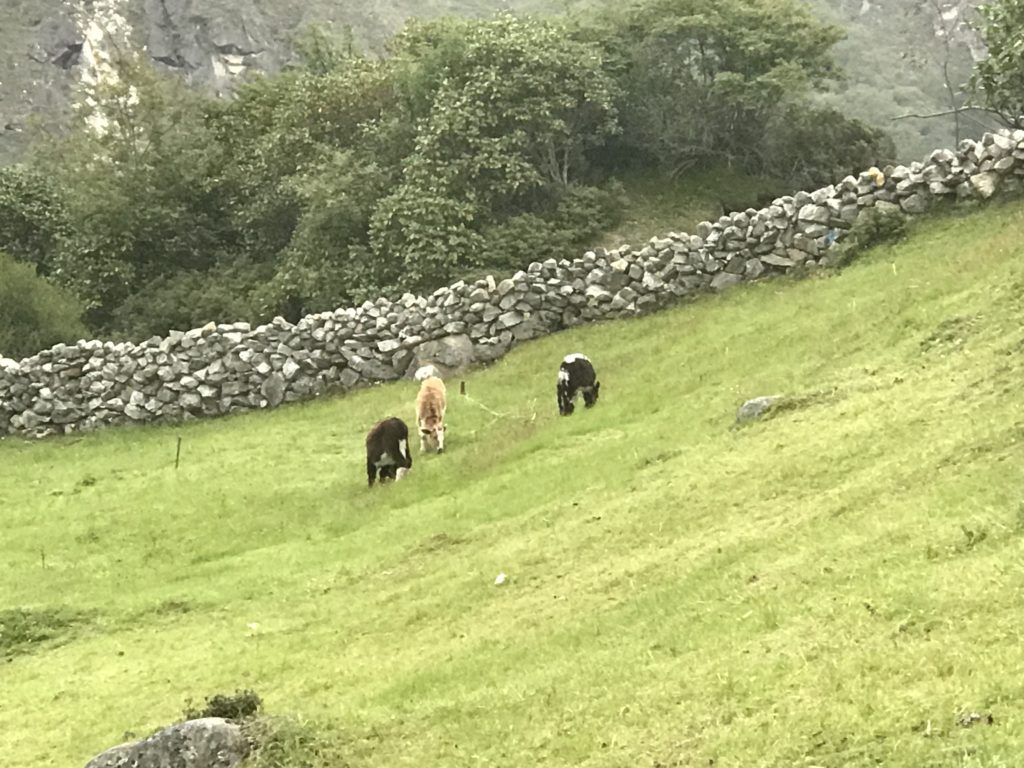
Cattle grazing in Dole 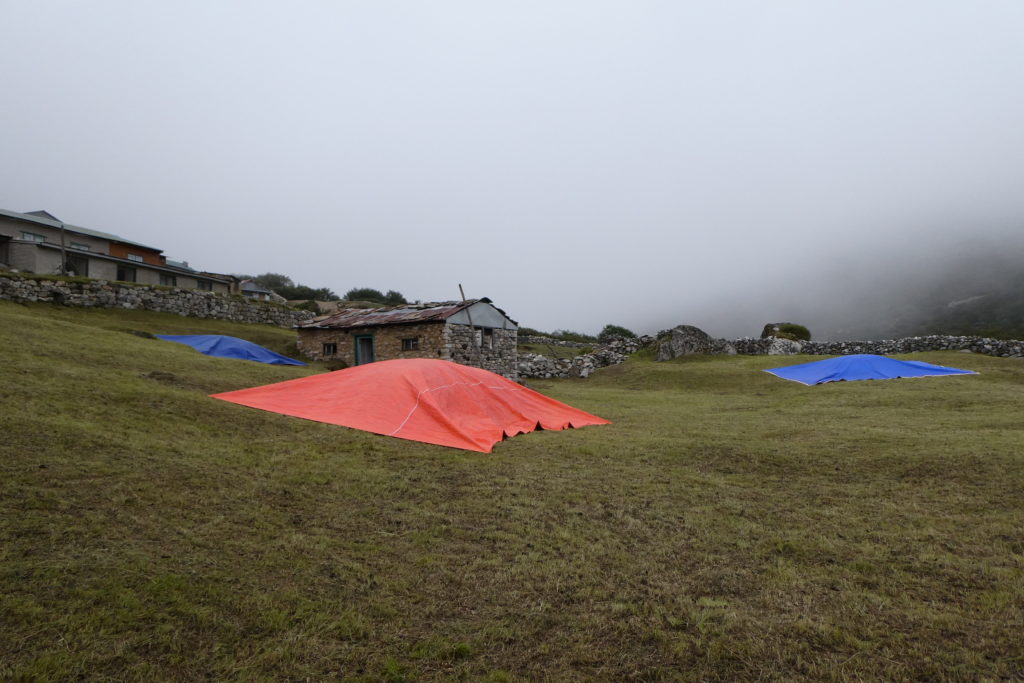
A cut grass field
A valley without villages
The Gokyo Valley follows the course of the Dudh Koshi River to its headwaters at the end of the long Ngozumba Glacier which reaches the foot of Cho Oyu (8,188 m). It is a valley where there are no permanently inhabited villages. There are a series of hamlet formed by lodges, or similar accommodation for tourists, or old settlements where in summer the Sherpas go with cattle to graze, since yore.
In fact, the main settlements between Namche and Gokyo, until the arrival of tourism, were settlements of this kind, which, due to their strategic location, have been consolidated as places for tourists. That is why many lodges have been built there in the last 25 or 30 years. They are the settlements of Dole, Luza, Macchermo and Gokyo.
They have nor schools neither community services as their inhabitants do not live there all year round and have their own home in lower villages, mainly Khumjung and Khunde. Part of the family lives there, especially the children, because that’s where the school is. Maccherrmo and Gokyo have a couple of small health care facilities, called rescue posts, sponsored by foreign foundations, open only in the spring and fall because they are designed primarily to serve tourists.
There are also smaller hamlets of lodges that have been built in other points along the way, such as Mong La, Phortse Tenga or Phang, where there is no other activity than accommodation during the tourist seasons and therefore you don’t find no one there in summer or winter.
A leisurely walk like the one we have done these days has also allowed us to discover a multitude of small settlements, often far from the main road, either at the bottom of the valley or hanging in places that seem inaccessible on the slopes of the valley.
They all follow the same pattern. They are settlements made up of many fields of grass, and some of potatoes, completely enclosed by stone walls, and with small rather precarious buildings, which serve as accommodation for them while they work there and to store the grass once. cut and dried, which will then be used to feed livestock in winter. It is in winter when cattle and their food go down to the villages below, where the owners have their home.
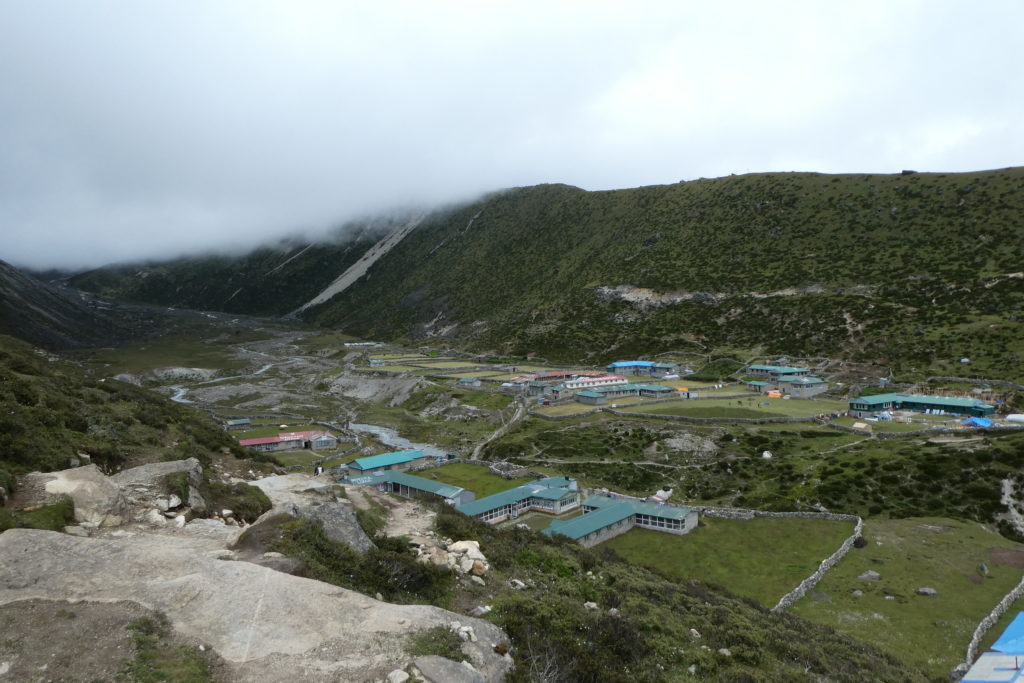
Machhermo (4,400 m) 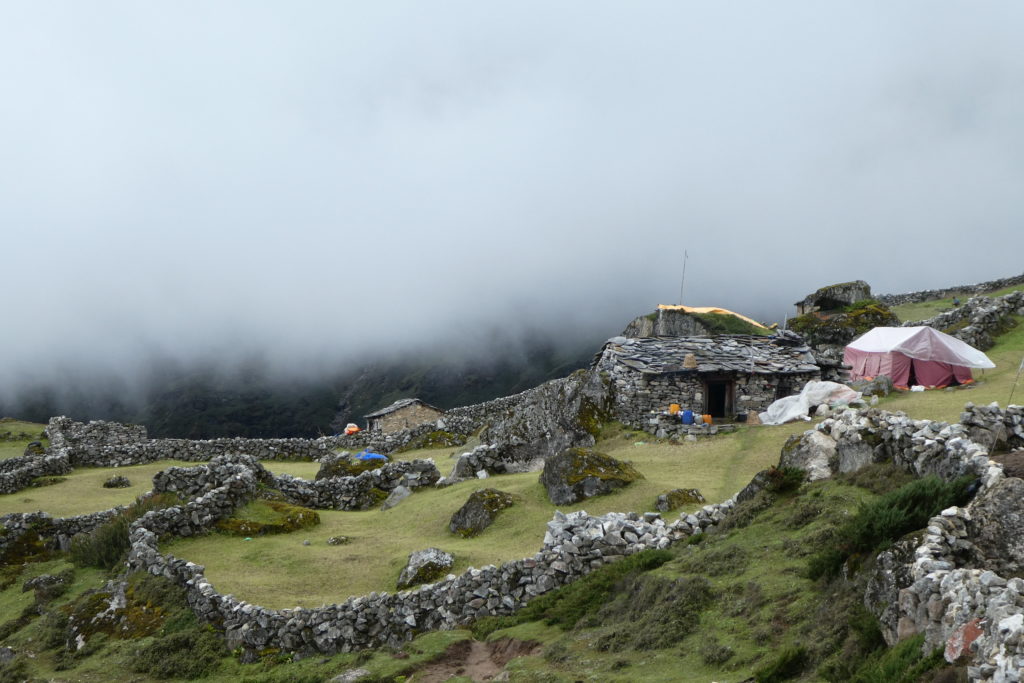
The small settlement of Karnasa (4,300 m)
Summer is a time of rain but also a time for building
We have seen on the roads many people carrying up building materials. Materials of many kinds but one to highlight. Wood. Here, houses are built mainly by stone and wood. They already have the stone in place, they just have to break it and shape it. They are very competent stonemasons.
But they have to bring the wood from very low, from where there are forests and they can get permission to cut it. The wood dealers take it by helicopter to Syangboche, just above Namche, there they sell it and from there it is carried, in “packages” weighing about 95 kg, loaded on their back and on foot, to the building sites where will be used. I would to point out that a person who carries a load of these, takes a couple of days until he gets his destination, he receives 7,000 rupees, half of which is spent on accommodation and food. He has 3,500 rupees left, or about € 28 for 3 days of work. And what a job!
The existing lodges do a lot of building works in the summer (everyone we visited had a site in progress) and some were building a new one. A small construction fever. However, in the tourist peak season, there is a lack of accommodation.
The sites are very well organized so that, if it rains, they can continue working. Carpenters, stonemasons and those who assemble the structures work under tarpaulins. Because they only have the summer to do the construction work, they can’t do it any other way.
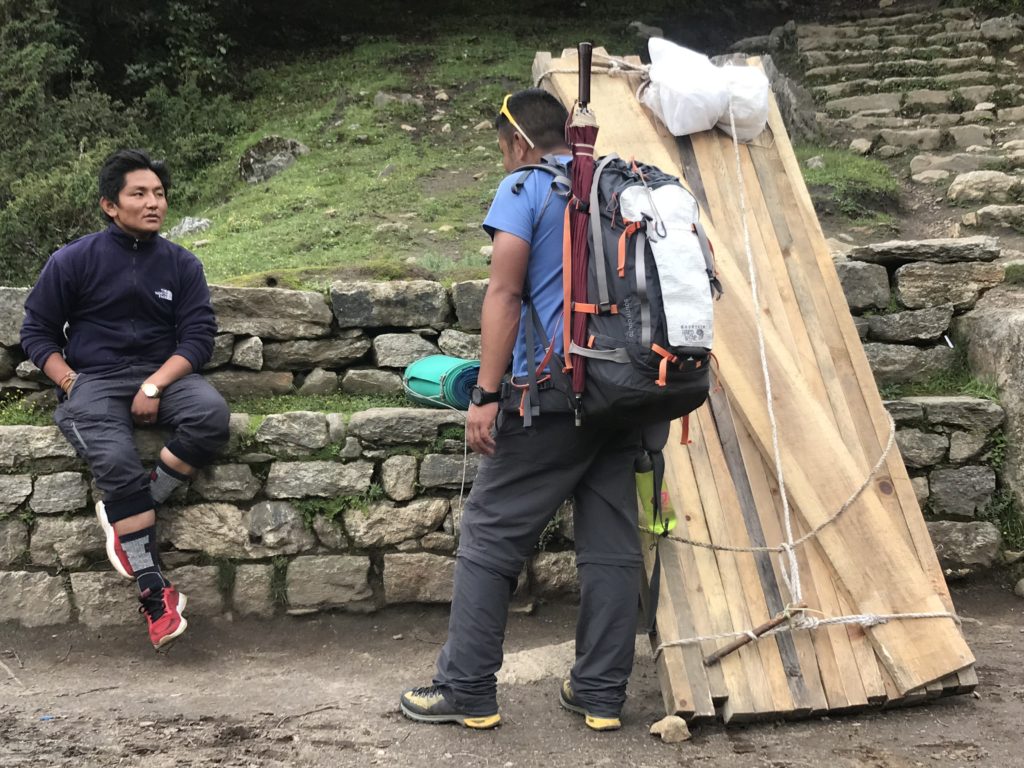
A rest during a wood transportation 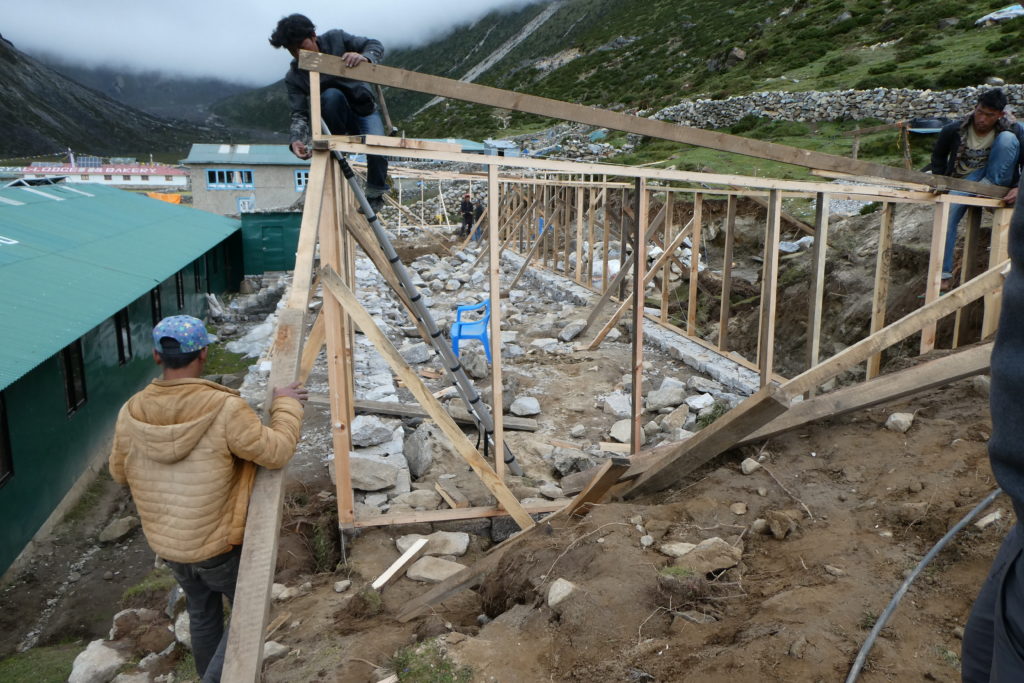
A lodge enlargement in Machhermo
A valley with two ways of life that in summer is only one
As you can already guess, the activity focused on tourism, which is the majority in this valley, and the strictly agricultural and livestock, in clear decline, show us two very different ways of life. The one with the most profitable tourism and the other with very little.
Now in summer, however, everything is agricultural and herding activity and lodges are almost all closed or under construction. We have therefore been able to see the same in the hamlets of lodges as in the small agricultural settlements. Cattle, especially yaks and naks, graze in the meadows, and people cut, dry and store the grass for winter. Because it is summer and it rains a lot, when they cut the grass they have to pile it up and cover it every day so that it does not get wet and many days more than once. During the day, if they see that it should not rain, they scatter it in the field and in the evening, or if it rains again, they pile it again.
A very important fact to highlight, from my point of view. The first lawn mowers have arrived in these places a year ago. They are our brushcutters! This is a small step towards a mechanization of agriculture that seems almost impossible here. One neighbour told me that the machine does the job seven times faster than doing it by hand. However, most people still cut hands.
I also want to highlight the great fondness for looking for wild mushrooms, by the way delicious, that these people have. Since it’s raining, now is the time for wild mushrooms. They are eaten fresh, but most of all, they are dried for the rest of the year.
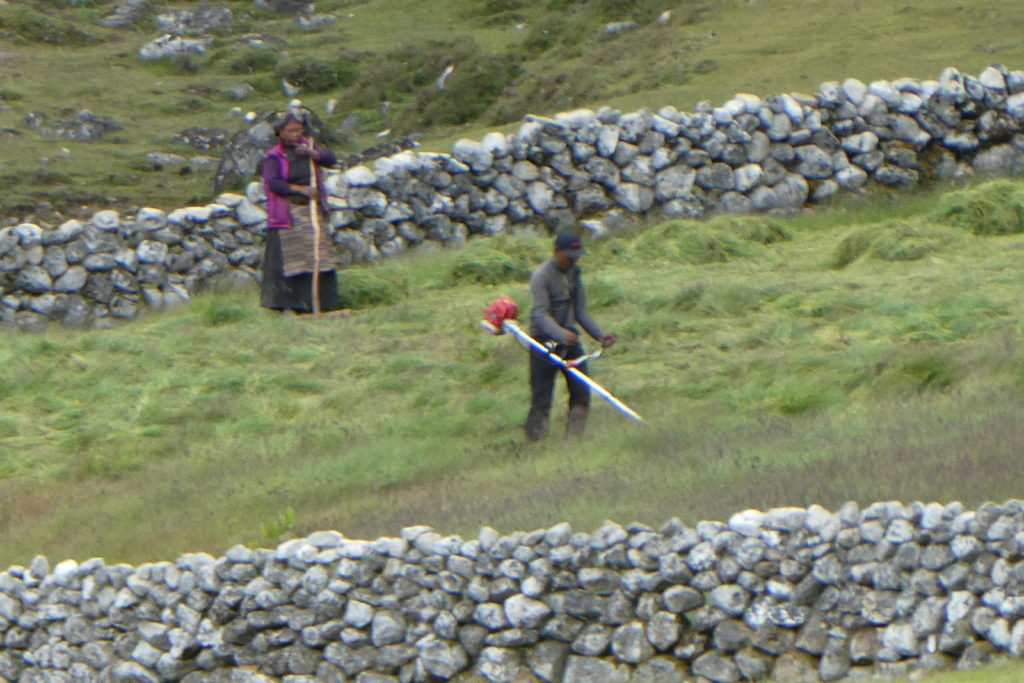
Cutting grass by machine 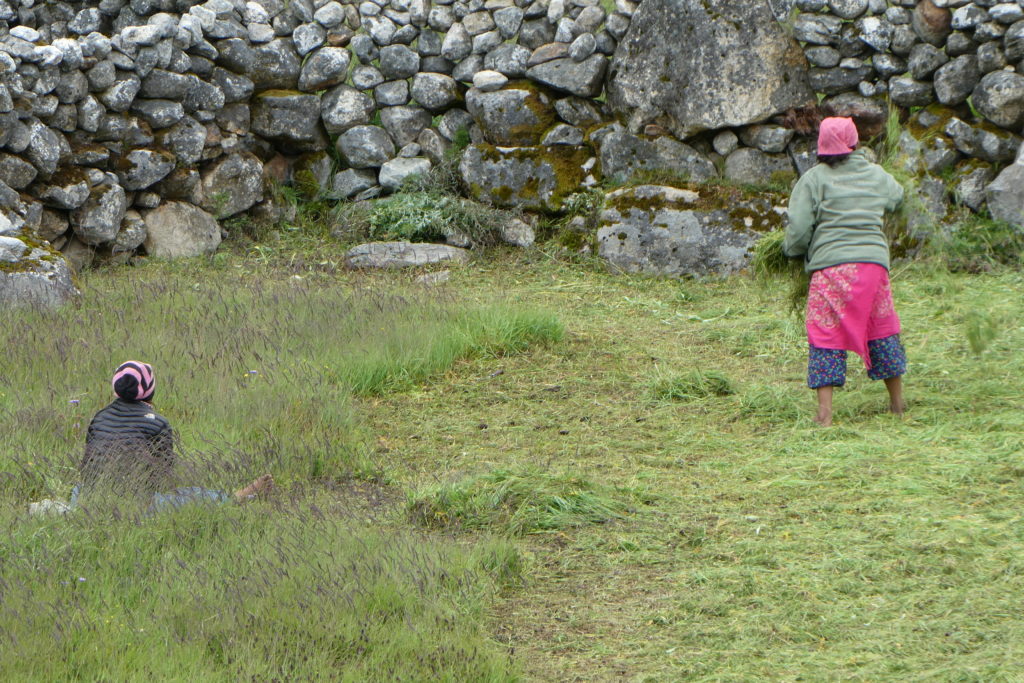
Still also by hand
A valley with two ways of life that in summer is only one
As you can already guess, the activity focused on tourism, which is the majority in this valley, and the strictly agricultural and livestock, in clear decline, show us two very different ways of life. The one with the most profitable tourism and the other with very little.
Now in summer, however, everything is agricultural and herding activity and lodges are almost all closed or under construction. We have therefore been able to see the same in the hamlets of lodges as in the small agricultural settlements. Cattle, especially yaks and naks, graze in the meadows, and people cut, dry and store the grass for winter. Because it is summer and it rains a lot, when they cut the grass they have to pile it up and cover it every day so that it does not get wet and many days more than once. During the day, if they see that it should not rain, they scatter it in the field and in the evening, or if it rains again, they pile it again.
A very important fact to highlight, from my point of view. The first lawn mowers have arrived in these places a year ago. They are our brushcutters! This is a small step towards a mechanization of agriculture that seems almost impossible here. One neighbour told me that the machine does the job seven times faster than doing it by hand. However, most people still cut hands.
I also want to highlight the great fondness for looking for wild mushrooms, by the way delicious, that these people have. Since it’s raining, now is the time for wild mushrooms. They are eaten fresh, but most of all, they are dried for the rest of the year.
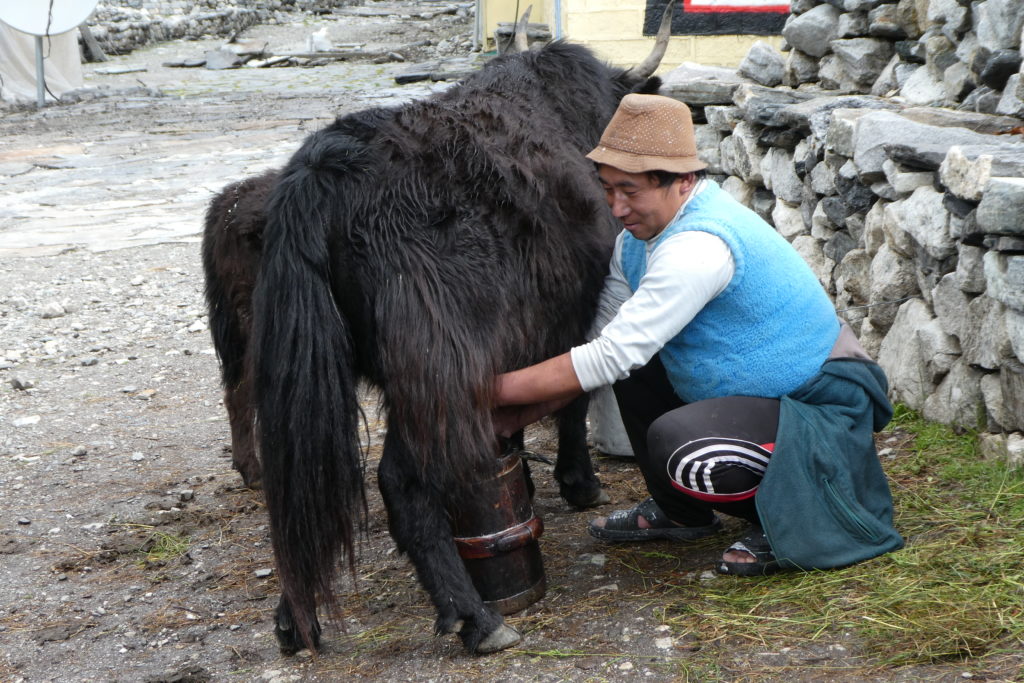
Milking a nak in Gokyo (4,780 m) 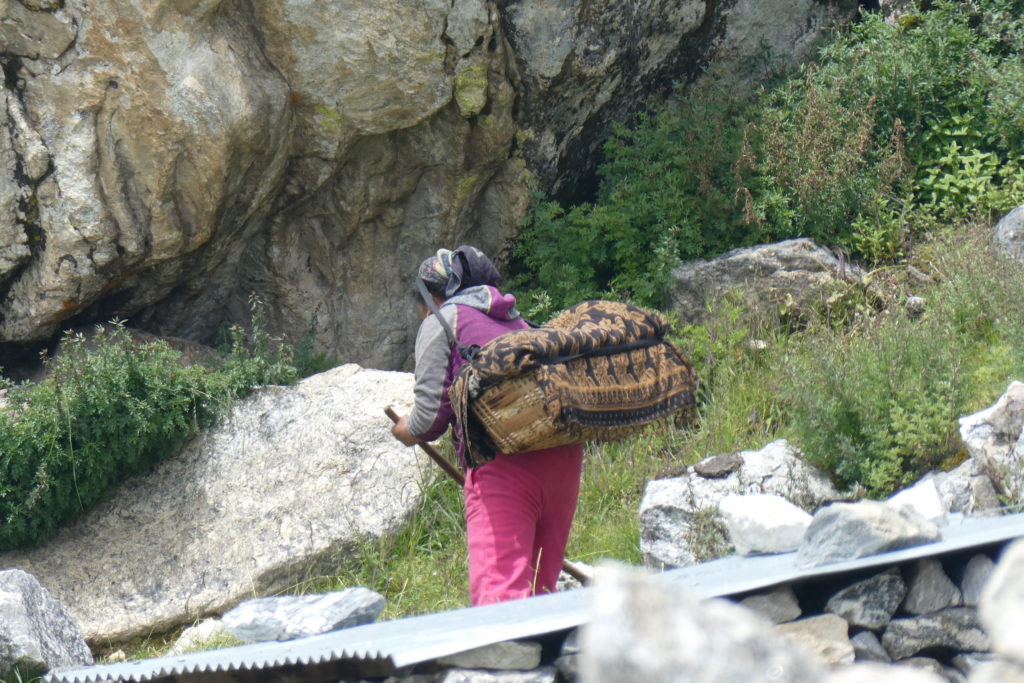
Woman doing agricultural work carrying a cod
At the bottom of the Gokyo Valley, descending to the left downstream, we come to what we might consider the fourth largest village in the upper Khumbu. It is the village of Phortse. But we will talk about the Khumbu villages another day.
Today I wanted to tell you about our experience of walking a week in the mountains, without haste, without people and with time to stop when you feel like it, talk to the local people, listen to their stories, legends or tragedies and, at times, living as they do, sharing table, cooking, and why not, drinking a glass of their liquor, the chhang. Doing this without feeling like a simple tourist but someone who listens to them, who is interested in their life, their religious practices, the expectations of their youth or their lack of service. This can only be done at times such as having no customers in the lodges and having time to be able to share with you. By the way, they are great conversationalists, among themselves. But the language barrier keeps me from participating!